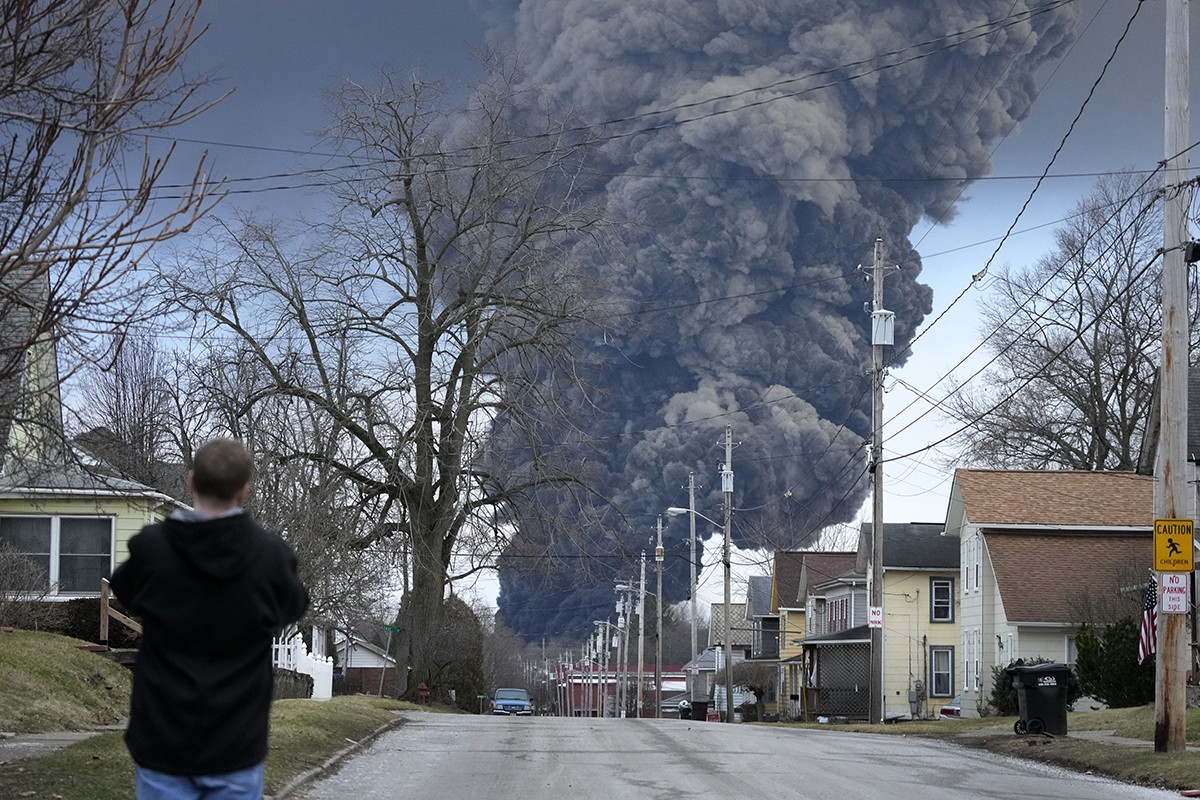National Transportation Safety Board Chair Jennifer Homendy cast doubt Wednesday on the justification for a controlled burn following a train derailment in East Palestine, Ohio last year. She spoke before the U.S. Senate Committee on Commerce, Science and Transportation. Some committee members focused on the recent mid-air door plug accident on an Alaska Airlines flight, but Ohio Republican U.S. Sen. J.D. Vance turned her attention to the disaster near Ohio’s border with Pennsylvania.
“Is it true that the chemical shipper, OxyVinyls, concluded that the reported and stabilized tank car temperatures were too low for a runaway chemical reaction, meaning, the sort of thing that would lead to an uncontrolled explosion?” Vance asked.
“That’s correct,” Homendy said.
“They had testified that polymerization was not occurring,” she added. “In order for polymerization to occur, which was Norfolk Southern and their contractors’ justification for the vent and burn, you would have to have rapidly increasing temperatures and some sort of infusion of oxygen, neither of which occurred.”
That directly contradicts the explanations for the controlled burn offered in its immediate aftermath.
The initial story
When emergency officials vented and burned vinyl chloride, it created a massive black pillar of smoke hovering over East Palestine. As the chemical burns, it breaks down into carbon monoxide and hydrogen chloride. Mixed with water, hydrogen chloride makes hydrochloric acid, which is toxic to fish. in the first few days after the controlled burn state officials estimated it killed 3,500 fish in nearby waterways. Burning vinyl chloride also creates a small amount of phosgene gas, a chemical weapon used during World War I.
In a press conference last February, Ohio Gov. Mike DeWine described how he was presented with “two bad options.”
“The risk of the car exploding was described to me as high,” DeWine said, “a high probability that it could explode.”
“The concern,” he added, “was it this would be a catastrophic, what was described as a catastrophic explosion of the of the car, which would result in shrapnel going out up to close to a mile.”
But Homendy explained expert testimony the NTSB has received undercut that assessment.
The NTSB’s findings
Vinyl chloride is an explosion hazard. A train car carrying the chemical under pressure with the temperature rising is effectively a bomb.
The problem is the NTSB has found temperature was not rising. Vance asked Homendy to confirm whether the initial temperature of 135 degrees had dropped and held at 126 degrees.
“That’s correct, Senator,” she said. “It was stabilized well, well before the vent and burn. Many hours before.”
He asked whether testimony from Norfolk Southern itself and the chemical shipper OxyVinyl described doubts or uncertainty about the immediate danger of an explosion. Homendy confirmed that it did.
Vance noted the emergency responders on the ground, including DeWine, were told they “had to make a decision in less than 13 minutes” without the benefit of hearing any contrary opinion.
“That’s correct,” Homendy responded.
She went on to add that OxyVinyl had employees on the scene, warning Norfolk Southern that they didn’t believe there was an out-of-control chemical reaction happening in the train car. “It was cooling down,” she insisted, but that information wasn’t relayed to decision-makers.
“When advice was given to the governor of Ohio, to the incident commander, they were not given full information because no one was told OxyVinyl was on scene,” Homendy said. “They were left out of the room. The incident commander didn’t even know they existed. Neither did the governor. So they were provided incomplete information to make a decision.”
Reaction
In a written statement, DeWine spokesman Dan Tierney emphasized the incomplete picture the governor received.
“Neither Gov. DeWine not incident command were ever presented with a scenario from experts that a controlled vent and release was unnecessary to prevent a catastrophic explosion,” he said. “They were also not presented any scenario where, if officials did nothing, the train cars would not explode catastrophically.”
“No one,” he emphasized, “not one single expert,” offered an alternative.
For his part, Vance wondered aloud if the decision to burn the cars was about getting trains back up and running.
“A lot of people, including me, are wondering, did they do this not because it was necessary, but because it allowed them to move traffic and freight more quickly?” he asked.
Ohio Democratic U.S. Sen. Sherrod Brown doesn’t sit on the committee, but responded furiously after Homendy’s testimony.
“This is outrageous,” he said. “This explosion — which devastated so many — was unnecessary. The people of East Palestine are still living with the consequences of this toxic burn. This is more proof that Norfolk Southern put profits over safety and cannot be trusted.”
The two senators co-sponsored legislation meant to increase railway safety, but that measure has yet to get a vote from the full Senate.
In a statement, Norfolk Southern defended its actions.
“The final decision to conduct a controlled release was made by the Incident Commander,” the statement read, “with input from multiple stakeholders, including Norfolk Southern and local, state, and federal authorities. The top priority of everyone involved was the safety of the community, as well as limiting the impact of the incident.
“The successful controlled release prevented a potentially catastrophic uncontrolled explosion that could have caused significant damage for the community,” the company stated.
Despite a move by activist investors to remove the company’s CEO, Alan Shaw, he received a substantial pay increase last year.
The NTSB has released its initial report about the East Palestine derailment. The final report should be released later this year.
This story was originally published by the Ohio Capital Journal and republished here with permission.






